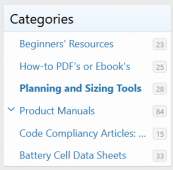birchfinnigus
New Member
- Joined
- Feb 18, 2021
- Messages
- 22
Hey guys, beginner here, but I've been planning my system for a while. Right now I'm focused on a 48v battery system that charges off of the grid and can be used to power house necessities in the case of a power outage. Eventually I will add solar into the mix when I figure out my panel placement.
The parts I've ordered -
I'm still doing my energy audit. According to the brochure, my mini split has a max heating power input of 5.1kw (it does not say kwh, I'm assuming it is?). But when I measure the power being drawn via my Sense home monitor, I'm not coming anywhere close to that. So I'm going to shut down everything but the mini split and the water heater and get some real world data.
I was delighted to see Will released some 48v videos with a DIY battery. So I'm using these as my guide.
Some questions I had -
The parts I've ordered -
- HYBRID LV6048
- 48V Overkill BMS
- 16x 3.2v 280AH Lishen Cells
I'm still doing my energy audit. According to the brochure, my mini split has a max heating power input of 5.1kw (it does not say kwh, I'm assuming it is?). But when I measure the power being drawn via my Sense home monitor, I'm not coming anywhere close to that. So I'm going to shut down everything but the mini split and the water heater and get some real world data.
I was delighted to see Will released some 48v videos with a DIY battery. So I'm using these as my guide.
Some questions I had -
- In Will's video he uses a 6 gauge wire. According to my specs, a 10 gauge wire should be fine, I don't anticipate pulling more than 200A. Should I go bigger?
- When getting a breaker from the battery to the inverter, should I be sizing to the job or just go with the max (200A)?
- What am I missing? This seems too easy.





